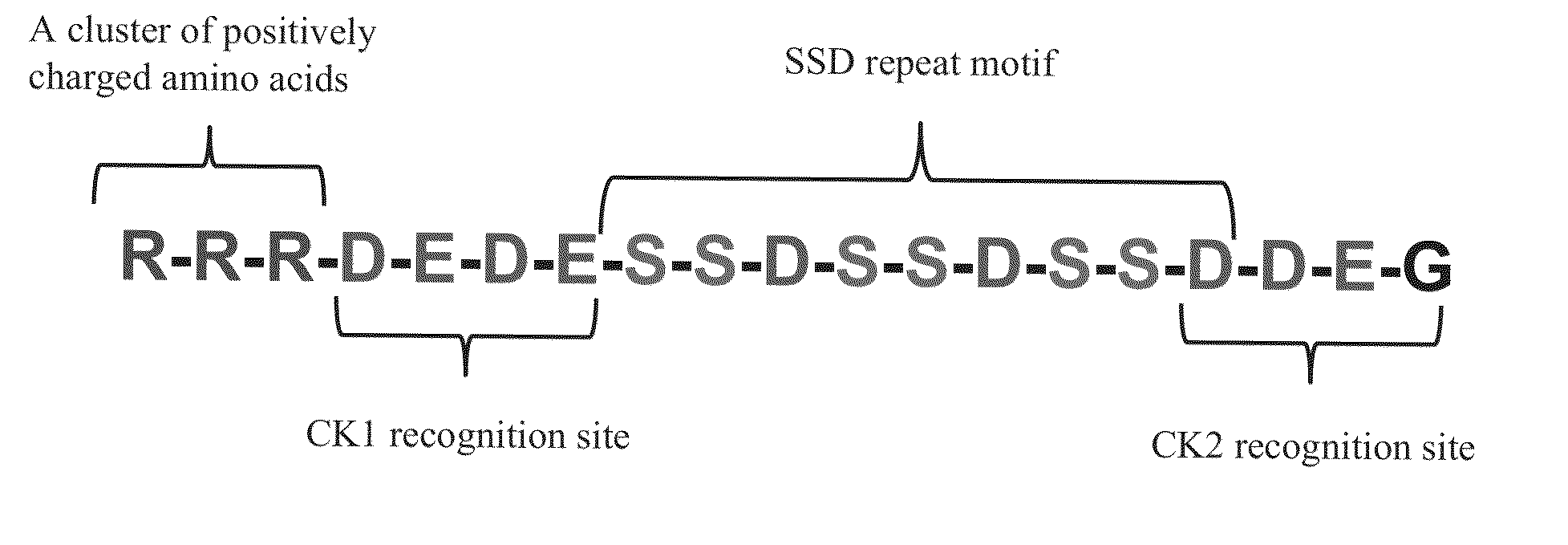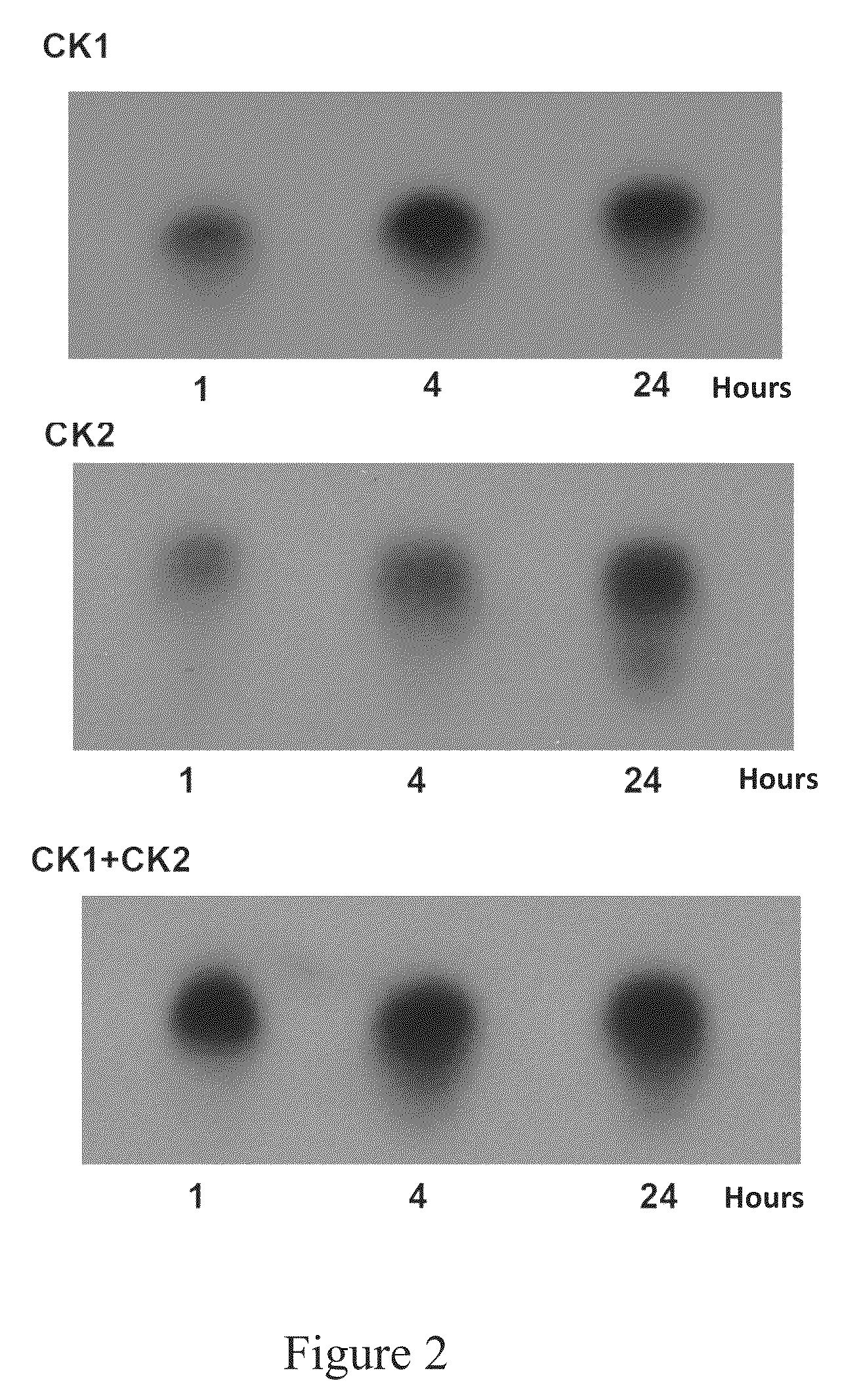Bone substitute nanocomposites and methods of synthesis using multiphosphorylated peptides
a technology of nanocomposites and peptides, applied in the field of biomimetic composites, can solve the problems of inability to synthesise bioinspired peptides, inability to bind to the material,
- Summary
- Abstract
- Description
- Claims
- Application Information
AI Technical Summary
Benefits of technology
Problems solved by technology
Method used
Image
Examples
example 1
Peptide Synthesis
[0042]The designed peptide: RRRDEDESSDSSDSSDDEG (R-SSD3) (molecular weight 2142.91 Da, at 92.26% purity) indicated by SEQ NO. 2 was synthesized by 21st Century Biochemicals (Marlboro Mass.). The purity of the peptide was determined using mass spectrometry and HPLC prior to shipment.
[0043]Casein Kinase 1 active (CK1) (0.2 mg / ml), Casein Kinase 2 active (CK2), (0.1 mg / ml) Mg / ATP cocktail, and P81 phosphocellulose paper were obtained from Upstate Cell Signaling Solutions (Lake Placid, N.Y.). Assay Dilution Buffer I and CK2 substrate peptide (1 mM), and active CK1 (0.25 mg / ml) were obtained from Millipore (Billerica, Mass.). Adenosine 5′-triphosphate, Ultratide / Isobluestabilized (ATP γ-32P) with a specific activity of 800 Ci / mmol was purchased from MP Biomedical (Solon, Ohio). 16.5% Tris-Tricine gel, 10× Tris-Tricine / SDS buffer, and Tricine sample buffer were purchased from Bio Rad Laboratories (Hercules, Calif.). ACS grade phosphoric acid (85%), ...
example 2
Tissue Culture in the Presence of Biomimetic DSS3 and DSS5 Peptides
[0069]DSS3 and DSS5 were dissolved in poly-L-lysine solution in DDW at the concentration of 10 μm / ml followed by coating of the polystyrene cell culture six well plates. The plates coated with poly-L-lysine only were used as a control. MC3T3 cells were seeded into the plates in triplicate and cultured for 15 days in non-osteogenic and osteogenic α-MEM tissue culture media. Alkaline phosphatase activity was used as a measure of osteogenic differentiation of the cells. In the osteogenic medium ALP concentrations were higher than in the controls. These differences were not statistically significant. However, there was observed between the controls and peptide treatments under non-osteogenic conditions in both DSS3 and DSS5 treated groups a statistically significant increase in ALP concentration (p<<0.05) as shown in FIGS. 8A and 8B. FIG. 8A shows the concentrations of ALP in the cell cultures over a 15-day period in the...
example 3
[0070]A collagen scaffold containing R-SSD5 indicated by SEQ NO. 2 peptide was implanted into a critical size defect in a rabbit ulna model. After 8 weeks, significant bone re-growth was observed as shown in FIG. 9. FIG. 9 shows a MicroCT reconstruction of the rabbit ulna critical size defect implanted with collagen carrier containing R-SSD5 indicated by SEQ NO. 2 peptide eight weeks after the surgery. As demonstrated in FIG. 9 in the right panel, significant bone re-growth was observed as compared to the control with no implant shown in the left panel. The results suggested that the peptide had osteogenic potential. FIG. 10A is a low-magnification image and FIG. 10B is a close up of the area in FIG. 10A identified by a rectangle, of H&E stained nondecalcified sections of the regenerating ulnar bone eight weeks after the surgery. FIG. 10A demonstrates almost complete bridging of the critical size defect by bone. The presence of cartilage between two newly fo...
PUM
| Property | Measurement | Unit |
|---|---|---|
| thick | aaaaa | aaaaa |
| thick | aaaaa | aaaaa |
| molecular weight | aaaaa | aaaaa |
Abstract
Description
Claims
Application Information
 Login to View More
Login to View More - R&D
- Intellectual Property
- Life Sciences
- Materials
- Tech Scout
- Unparalleled Data Quality
- Higher Quality Content
- 60% Fewer Hallucinations
Browse by: Latest US Patents, China's latest patents, Technical Efficacy Thesaurus, Application Domain, Technology Topic, Popular Technical Reports.
© 2025 PatSnap. All rights reserved.Legal|Privacy policy|Modern Slavery Act Transparency Statement|Sitemap|About US| Contact US: help@patsnap.com



